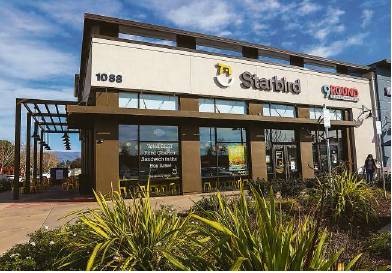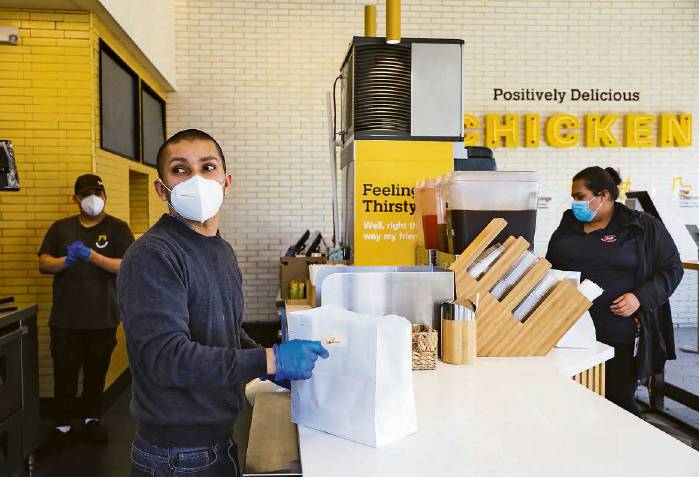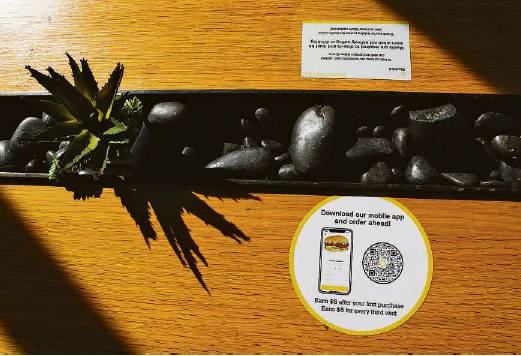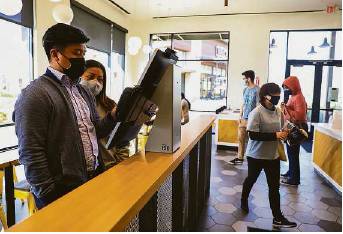Pandemic feeds profit for restaurant chains
Franchise prospects ‘just nuts’ amid to-go demand
By Elena Kadvany
In November, even as many restaurants continued to struggle or close because of the pandemic, Bay Area chain Starbird Chicken announced it had raised $12 million in capital, its fried chicken restaurants were seeing 26% growth in sales over 2020 and many more locations were on the way.
“This year has been a phenomenal one for Starbird,” CEO Aaron Noveshen said in a news release.
It was a strikingly optimistic announcement for the food industry, which saw an estimated 90,000 restaurants close nationwide during the pandemic. But with landlords seeking known brands for open spaces and the strong appeal of fast-casual spots like Starbird, restaurant chains and franchises are now faring better and in some cases seeing sales even higher than pre-pandemic.
San Jose-born Nick the Greek has 39 franchises in the works. Starbird is opening two Bay Area restaurants this year and has at least four leases signed in Southern California. Curry Up Now, a fast-casual Indian chain that started as a Bay Area food truck in 2009, plans to open 11 more restaurants, including in Texas and Georgia. Paris Baguette, a Korean chain that runs 4,000 bakeries globally, is planning 12 new franchises in the Bay Area and signed over 100 franchise agreements overall last year. Even Grégoire, a tiny, 20-year-old French restaurant in Berkeley, is planning to franchise.
Though plenty of chains had high-profile struggles over the last two years, this new planned growth appears to be proving a pandemic prediction that many shuttered independent restaurants would be replaced by chains.
Chains are often associated with the idea of mass-produced, commodity fast food, and a rise in such fare may be one impact of this new growth. But there’s a potential silver lining: Some businesses, like Curry Up Now, hope it will be an opportunity to bring lesser-known food to the American mainstream — a future in which diners order chicken tikka masala burritos in drivethrus just like a burger and fries.
Dan Rowe, CEO of national franchise development company Fransmart, said the current rate of growth is “unprecedented” unlike anything he’s seen in two decades in the industry.
“You’ve got this supply and demand balance back in the favor of the restaurants that are still standing,” said Rowe, whose company works with Bay Area restaurants including Curry Up Now and Ike’s Love & Sandwiches. “Good concepts that have money are actually out attacking right now. The opportunities right now are just nuts.”
***
With a third of U.S. restaurants closed during the pandemic, there’s real estate available and landlords are eager to cut deals, even in the pricey Bay Area, Rowe and restaurateurs said. Landlords who suffered financial losses during the pandemic are keen on renting spaces to businesses with deeper pockets.
“Landlords are skittish right now,” said Starbird’s Noveshen. “As sites come up, who’s got more money in the bank and who’s a safer person to rent to?”
After a recent trip to downtown San Francisco, Rowe said, “You just salivate looking at these (vacant) spaces.” It’s become a “tenant’s market,” he said. “Where three years ago you couldn’t find or afford real estate, landlords are throwing keys at you.”
The chains that are expanding have something else in common: Many don’t have table service and depend less on indoor dining. They can move into spaces with smaller footprints, or open as ghost kitchens in neighborhoods that don’t see a lot of foot traffic. Most were geared toward takeout and delivery before the pandemic, including with drive-thrus.
Pete Knight, a franchisee of the American diner chain A&W, said overall sales are up as much as 30% at his restaurants in Lodi and St. Helena, and their business is mostly drive-thru. Curry Up Now owner Akash Kapoor is looking for drive-thru spaces for the first time and is encouraging his franchisees across the country to do the same.
Curry Up Now has also been opening smaller spaces on college campuses, including Stanford University. Starbird Chicken, meanwhile, operates four virtual brands, from wings to plant-based chicken sandwiches. Its San Francisco ghost kitchen, which houses the virtual spin-offs, is seeing double the sales of Starbird’s brick-and-mortar restaurants, according to Noveshen.
Starbird Chicken also has its own app, ordering kiosks and a digital system for managing everything from production to inventory. Paris Baguette built food lockers where customers scan their phones to access pickup orders of cakes and pastries — no human interaction required.
While Nick the Greek’s Bay Area restaurants saw dine-in business drop in spring 2020, delivery sales rose by as much as 20%, and have stayed up. The company expanded last year, adding five franchises that serve its gyro wraps and bowls.
“We’ll lose seats before we make our kitchen smaller” and compromise on to-go demand, said Rob Crider, Nick the Greek’s director of franchising.
***
Whether all these new locations will actually open, or survive long-term, remains to be seen. Despite the current boom, large restaurant companies were not left unscathed by the pandemic. Numerous chains and franchisees declared bankruptcy in 2020, from California Pizza Kitchen to the U.S. arm of Le Pain Quotidien. Subway closed an estimated 2,200 to 2,400 locations, though some closures were temporary, according to Restaurant Business.
Peter Lagarias, a longtime franchise attorney in San Rafael, said the industry offers plenty of cautionary tales, and that excited press releases about ambitious expansions should be taken with a grain of salt.
There’s a phenomenon in the franchise world called SNO, or “sold not open”: promises of future franchises that have been sold, but never come to fruition. Sometimes it’s due to a challenging real estate market, as in the Bay Area, while other times it’s because of an overly ambitious agreement, Lagarias said. The collapse of Quizno’s is a classic example: The fast-food sandwich company at one point sold over 500,000 franchises, but shrank to fewer than 400 locations by 2017, according to media reports.
In franchising, the original owner licenses their food and brand to franchisees in exchange for a portion of sales. Nick the Greek, for example, asks for an initial $35,000 franchise fee and then charges a royalty fee equal to 6% of gross sales. Franchisors often try to sell more restaurants by offering deals, such as reducing the initial franchise fee if a franchisee agrees to open multiple locations. But franchisees are not always able to open two or three restaurants.
“Keep that in mind when people are saying that there’s an explosion of new franchises,” Lagarias said.
For instance, A&W, which sells burgers and root beer floats at hundreds of locations across the country, announced in November that the chain wants to open 12 new restaurants in the Bay Area. The announcement championed the company’s “ninth straight year of positive growth, surging 9.7% — despite the global pandemic.” Yet when The Chronicle asked about new outposts, John Palumbo, A&W’s senior director of franchise development, said in a statement: “We don’t have any immediate plans to grow, but we are looking for qualified candidates to join our brand in the future.”
Plus, larger chains, while often better equipped to weather the COVID-19 storm, are not immune to the labor and supply-chain challenges facing restaurants. Rowe of Fransmart says his company can help restaurants hire when others can’t by using its national database of staffers and access to national recruiting firms. Other owners have said that positive work culture and competitive pay will enable them to hire when they open dozens of new locations.
But the reality won’t become clear until the restaurants are up and running. Many fast-food restaurants struggled to attract workers during the pandemic despite raising wages. According to the National Restaurant Association, the restaurant industry lost 2.5 million workers during the pandemic.
Andrew Freeman, founder of restaurant consulting firm AF&Co and co-founder of brand communications agency Carbonate, is confident chains won’t wipe out independent restaurants, especially in the Bay Area. Local diners are generally prone to support independent makers, he said. Antichain sentiment also intensified during the pandemic, with calls to support mom-and-pop restaurants over chains. Many diners also seem to appreciate that a corporate chain is not the same as a locally born one, said Freeman, such as Gott’s Roadside, which was once a single Saint Helena restaurant but now has eight locations.
That said, opening a chain location or franchise through a company already well-versed in technology and social media savvy has real appeal, Freeman said.
“That’s why the cost of doing a chain opening or a franchise opening is definitely less,” he said. “It’s that cookie-cutter model that you can plug in.”
Resistance to chains is something Kapoor of Curry Up Now understands. When he and his wife, Rana, started the business, he never wanted to franchise due to the stigma. “Everyone talks very negatively about it, even today,” he said. “There are a lot of brands that want to franchise but don’t because they feel their brand is going to lose their charm or their soul.”
But Kapoor has a bigger dream: to expose more of America to Indian cuisine through dishes such as paneer-topped fries and chicken biryani. Without serious capital, he wouldn’t be able to open new restaurants at the same rate as he can by franchising. With this model, he can bring Indian fast food to cities in Georgia, Indiana and Texas, which he has targeted based on demographics and tech growth that echo the Bay Area.
A similar vision drove Umesh Patel of Pav Bhaji Hut to expand through franchising: He sees a future where pav bhaji, a regional Indian street food dish, is a fast-food staple in major U.S. cities. The restaurant, which started as a food truck in a Sunnyvale parking lot in 2018, serves only its namesake dish, a famed Maharashtrian stew that’s not as well-known to Americans.
Pav Bhaji Hut just opened its first franchise location, also in Sunnyvale, and Patel is in talks to open franchises in Seattle, Arizona and on the East Coast.
The first franchisee, Pramoda Ramachandra, is a former dietician and hospital director who’s never run a restaurant but fell in love with Pav Bhaji’s food and mission. “A lot of times the Indian food we eat (in the U.S.) is so diluted or mainstream. It tasted like how it tasted back in India,” she said.
She’s passionate about Patel’s vision of bringing pav bhaji to a wider swath of diners. So far, it appears to be working: The new franchise has sold out by 8 p.m. most days since it opened in late December. Many customers are people who are trying pav bhaji for the first time.
Elena Kadvany is a San Francisco Chronicle staff writer. Email: elena.kadvany@sfchronicle.com Twitter: @ekadvany




